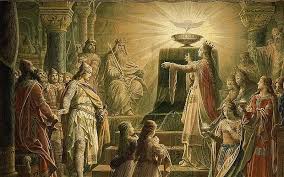Vaša košarica je trenutno prazna!
The enduring connection between the Knights Templar and the Holy Grail is one of history’s most captivating and persistent myths. This intriguing narrative, deeply embedded in popular culture, suggests that the medieval warrior monks, renowned for their power and secrecy, were the guardians of Christianity’s most sacred relic. But did the Templars truly protect the Grail? While the myth has survived centuries, fueled by layers of symbolism and an aura of profound mystery, historical evidence offers a different answer.
The legend of the Holy Grail, often depicted as the cup from which Jesus drank at the Last Supper or which caught his blood at the Crucifixion, predates the Templar order itself. Its origins lie in medieval Arthurian romances and chivalric literature of the 12th century, evolving from a mystical vessel of sustenance to a symbol of divine grace and purity. The Knights Templar, on the other hand, were founded in 1119, nearly a century after the earliest Grail narratives began to emerge. Their primary mission was to protect pilgrims in the Holy Land and defend the Crusader states.
Crucially, there is absolutely no historical or archaeological evidence to suggest that the Knights Templar ever had any involvement with or even knowledge of the Holy Grail. Their extensive financial records, charters, and contemporary chronicles, while detailing their vast landholdings, military campaigns, and financial dealings, make no mention whatsoever of the Grail. The Templars were a well-documented order for their time, and such a significant treasure would undoubtedly have appeared in their records or in the accusations leveled against them during their suppression in the early 14th century.
So, how did this compelling myth take root? The connection largely stems from 19th and 20th-century speculative fiction and esoteric literature. Authors, captivated by the Templars’ dramatic rise and fall, their perceived secrecy, and their strong ties to the Holy Land, found a perfect convergence point with the mystical allure of the Grail. The image of a powerful, enigmatic order safeguarding an ultimate spiritual artifact resonated deeply, especially as the Templars were viewed by some as victims of injustice.
Ultimately, the myth of the Templars protecting the Holy Grail is a testament to the power of storytelling and the human fascination with mystery. It beautifully intertwines historical figures with profound spiritual symbolism, creating a narrative far more compelling than historical fact. While scholars consistently debunk the link, the legend’s survival highlights our enduring desire for hidden truths and heroic guardians, ensuring the Templars and the Grail remain forever linked in the public imagination.

